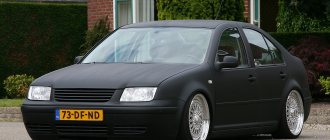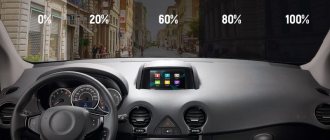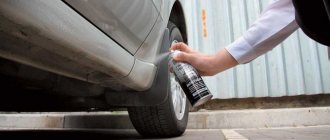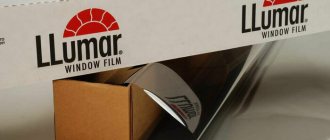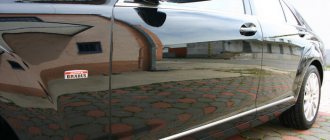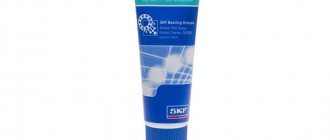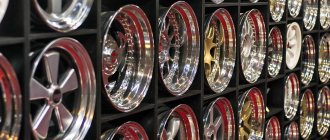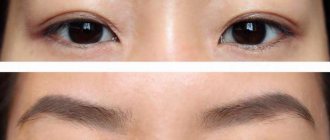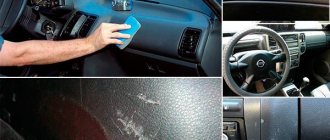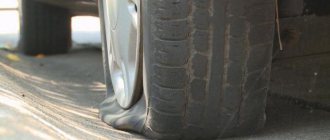Types of protective film
Vinyl
Usually this is a transparent protective film for cars, it is relatively inexpensive and is in great demand among car owners, it has high elastic properties, is durable, easy to apply to all parts, and can be quickly dismantled.
Types of vinyl film:
- glossy;
- graphic;
- matte;
- colored;
- transparent;
- mother-of-pearl;
- with metallic effect;
- textured.
It not only protects the vehicle, but also decorates it.
Vinyl film is in great demand
Types of camouflage film:
- digital;
- military;
- by plant species;
- in the form of animal skin;
- art camouflage.
Polyurethane
Performs the same functions as vinyl. It has high strength and tolerates temperature changes well.
Polyurethane film has high strength
Mirror
Most often, film is applied to the windshield; it does not allow ultraviolet rays to pass through, makes the glass more durable, and decorates vehicles.
Film is also distinguished depending on the method of its production:
- Calendered - the film is made from polyvinyl chloride granules. This is the most economical option for car wrapping. Such materials have a low level of ductility, they are very easy to damage during application, and after removing the film from the car body, traces of glue may remain. Also, this film does not have a very good adhesive layer, therefore it holds less reliably.
- Cast film - it is cast from vinyl. It stretches well, is much thinner compared to calendered film, and does not shrink during use. Its cost is much more expensive due to its excellent physical and chemical properties. It is easy to remove from the coating, as it does not leave traces of glue on the surface.
Reserving a car with film helps extend its service life, save money on repairs and protect the driver and passengers in the event of an accident, since it holds glass fragments in the event of a collision.
Reserving your car with film helps extend the life of your car.
What is a protective film?
Protective film is a material that can be used to protect surfaces that are susceptible to damage. These injuries include minor to moderate abrasions, scratches and more. These films typically vary in thickness, material, and adhesive strength.
Based on various combinations of these characteristics, these films can be suitably used in various scenarios to prevent damage.
What's interesting about these films is that they were originally developed for military purposes. Back in the 1960s, the US Department of Defense realized that helicopter blades could not avoid damage caused by debris in the air.
This problem eventually prompted the creation of a protective layer that was designed to be clear, lightweight, and strong enough to prevent damage to military equipment in use.
These protective layers, or "helicopter tape" as it was called, eventually evolved to include modern vehicles.
Application of anti-gravel film technique and pitfalls
Types and features of files, recommendations for selection
Before starting work, you need to moisten your hands with soapy water. It also needs to be sprayed onto the film layer containing the glue. This will solve the problem of dust sticking to it and contamination of the adhesive layer. You can unwind the film either directly from the roll or by cutting out the necessary templates and then separating the liner.
Next comes work with a rubber squeegee. It must be firmly fixed in your hand and moved at an angle of 45-60 degrees to the surface. Each pass of the tool should overlap the previous one by half and not leave air or water bubbles under the film. If they do appear, they can be removed by injecting an alcohol solution through a syringe. The same applies to the “fingers” that arise when working with the edges of parts. We must not forget about constantly moistening the working surface with soapy water.
Description of the protective film application process
Any modern protective film has excellent elasticity, so working even with sharp bends or difficult areas is not very difficult. But do not tighten it excessively; such an action may lead to the appearance of traces of damaged glue.
After covering the car with a protective film is completed, the surface must be treated with an alcohol solution and wiped with a dry, clean cloth to make sure there are no bubbles and to clean the invisible barrier that has formed. It is not recommended to wash the car within 24 hours after the transparent film has been applied. The use of abrasive pastes for polishing is undesirable.
Conditions for covering a car with anti-gravel film
Sealants for heating radiators: types and features of choice
The first condition under which a transparent anti-gravel film can be applied to a car is the cleanliness of the body. Therefore, the most preferred method of cleaning the paintwork and joints is to pressure wash the car. This procedure can be ordered at any car service or car wash. Scratches present on the paintwork must be polished, and traces of paste must be carefully removed.
Car protection with anti-gravel film
The room for covering a car with anti-gravel film must meet a number of requirements. Firstly, it must be well lit. Secondly, there should be no effect of wind on the car body. These two factors can allow dust and sand to get under the film, which will negatively affect its performance characteristics. The temperature in the room should be within 17-32°C, since the installation fluid can evaporate quickly.
Any modern transparent protective film is very elastic, which facilitates its comfortable application and reliable fixation on the body, even in hard-to-reach places. In addition, having heated the product to the required temperature, it can be easily tucked over the edges of the parts
But it is important to remember that exceeding the temperature of 70 degrees is extremely undesirable, since the film may lose elasticity and some protective properties
Anti-gravel film testing
Pasting with anti-gravel film in Moscow
Anti-gravel body protection in Moscow: installation technology
Installing an anti-gravel film on a car requires following a certain sequence of actions, which will ensure a long period of operation. Before covering a car with anti-gravel film, the headlights or body are first polished. Pasting the car with anti-gravel film is carried out on a previously cleaned and degreased body or its individual elements. Next, the parts are treated with a mounting solution and anti-gravel pasting of the body is performed. After this, the anti-gravel car wrap is smoothed with a rubber squeegee.
If a car is covered with anti-gravel film in Moscow in winter, the material in difficult areas is heated with warm air from a hairdryer. When the car wrap is completely completed, the polyurethane anti-gravel film must still dry for 12 hours.
Anti-gravel protective film on a car, which is installed correctly, does not change the color of the car and does not distort the light of the headlights.
Anti-gravel car wraps in Moscow: types of films
Car protection with anti-gravel film can be made using materials of different technical characteristics. Among the most popular are anti-gravel protection films of the following types in the city of Moscow:
- wrapping a car with polyurethane film;
- automotive protective vinyl film, more affordable in price;
- covering the car with armored film.
Full armoring with anti-gravel film or processing of individual parts or glass can be performed.
Pasting with anti-gravel vinyl film in Moscow
Covering a car with vinyl film is more flexible and cheaper than covering a car with polyurethane film. It is thinner and less suitable for protection against scratches than polyurethane pasting, since it is easily deformed. But gluing it to a car will be inexpensive and will perfectly protect the body from ultraviolet radiation and fading.
Over time, such material hardens in the cold and turns yellow, and the protection decreases, so many car owners prefer to apply a polyurethane film of higher quality.
Car protection with polyurethane film
A denser and more durable polyurethane film on a car better protects against damage and its installation in the city of Moscow is more in demand. Gluing polyurethane film provides higher protective properties against scratches, chips, abrasions and stones flying from under the wheels. Also, the polyurethane treatment of the car will protect it from falling branches and other objects.
The material has low elasticity, so covering a body with polyurethane film is a rather complex process that requires certain skills and the availability of appropriate tools. To stick it on the convex parts of the front of the car, experience and high professionalism are required.
At FEYNLAB, polyurethane car wraps in Moscow are performed by qualified craftsmen who have completed a special international-level training course.
Covering a car with polyurethane film: advantages and disadvantages
Due to its strength, polyurethane body protection has received the name “light armor” from car owners. Installing polyurethane film on a car from well-known manufacturers allows you not to worry about the integrity of the paintwork, as well as headlights and bumpers. They most often prefer to install a kind of armor with polyurethane film on the thresholds; protection of headlights, hood and mirrors with this film is also in demand.
Pasting a car with polyurethane film has a number of advantages:
- car protection with polyurethane film allows you to preserve the natural color of body parts;
- polyurethane treatment is easy to maintain and its dismantling occurs without negative consequences for the paintwork;
- Pasting with polyurethane film in the city of Moscow will protect the headlights and hood inexpensively.
You can glue high-quality film in the south of Moscow at the FEYNLAB detailing center at any convenient time, having agreed in advance with the manager by phone. Our craftsmen apply polyurethane film to cars using modern technologies, and its installation in Moscow is one of the most affordable.
Taking into account the dense traffic of cars in the city of Moscow, polyurethane film protection will protect the car’s coating from minor damage. Just call our center and its specialists will be able to stick polyurethane film on the car in accordance with the client’s wishes.
It should be noted that the thickness of the material plays an important role in the quality of protection, but covering complex geometric surfaces with high-density polyurethane film is quite problematic. Only craftsmen with extensive experience know how to tighten the material smoothly in order to cover the wings or bumper as thoroughly as possible.
Polyurethane protection in our Moscow center is carried out with films from the best manufacturers who supply exclusively high-quality material.
Anti-gravel treatment of the underbody of a car in Moscow is carried out with a high-quality matte film, the shelf life of which is 5-7 years. Having decided to cover it with cheaper analogues, every car owner should understand that such a sticker will have a shorter period of protection.
Covering the body with armored film - a reliable shield of paintwork
Professional wrapping of a car with armored film in Moscow will help preserve the car’s paintwork under active use conditions. Even the most careful drivers prefer to cover their cars with armored film to avoid many negative factors.
Pasting armored film on a car will protect it from many unforeseen situations:
- damage in a parking lot or parking lot;
- minor accidents, without major damage;
- actions of vandals or ill-wishers.
Armored film on a car and its installation will save your nerves and protect you from minor troubles on the road. But it should be remembered that such material is made from a special polyurethane composite and it is impossible to stick armored film on a car without professional training.
Covering a car with armored film at FEYNLAB Detailing Moscow will cost a little more, but this will allow you to create a reliable protective screen from many troubles that await the car owner on the road.
By contacting the FEYNLAB detailing center, you can choose any material and cover a regular or premium car with polyurethane film. Only the owner can know his driving style and how much protection his car requires.
Features of protective films in Autosecurity
Engine oil pressure sensors: types, features and testing methods
offers anti-gravel protective films that are ideal for application to the car body of any shape (including aftermarket sports body kits and tuning elements).
American SunTek film (total thickness 200 microns) can be applied to all body elements; it stretches well without changing the protective functions. The coating does not lose its aesthetic appeal (does not turn yellow, does not crack, does not become cloudy) for 10 years. An undeniable advantage is the absence of the need for special care. The adhesive layer of polyurethane film has excellent adhesion. SunTek coating can be applied not only to cars, but also to all types of water and air transport.
- The cost of covering one body element with SunTek film is from 1,500 rubles.
- The cost of comprehensive wrapping of the front part of the car with SunTek film is from RUB 36,000.
Among the features of KPMF vinyl films, the ability to operate in harsh temperature conditions from -50°C to +110°C should be highlighted. Service life reaches up to 7 years. Despite its small thickness of 100 microns, the KPMF film acts as an effective protection against scratches, reagents, and damage in minor accidents.
- The cost of covering one body element with KPMF film is from 650 rubles.
- The cost of comprehensive wrapping of the front part of the car with KPMF film is from RUB 17,300.
- The cost of covering one body element with Ricochet HYBRID film is from 900 rubles.
- The cost of comprehensive wrapping of the front part of the car with Ricochet HYBRID film is from RUB 21,300.
We work only with professional films, the adhesive layer of which is designed for adhesion to the paintwork of modern vehicles! Therefore, if necessary, you can always remove the film from the car body without damaging the paintwork.
Order a cost estimate for covering your car with protective film from Autosecurity managers right now. We guarantee you the best value for money.
Film on the hood
The decision to cover the hood with film will help you protect your car and yourself from many unpleasant problems associated with damage to the coating and the need to repair it in the future. We offer a wide selection of materials and provide, among other things, the service of covering the hood with film. To do this, we use high-quality vinyl and polyurethane films; we do the work carefully and quickly. You can be sure that your car will look impeccable and will be reliably protected.
Our shopping center AvtoPro99 is located in Moscow and operates according to a very convenient schedule: seven days a week, from 09.00 to 22.00.
We use the highest quality films!
Hood protection film
The protective film on the hood will keep the car's paintwork in unchanged condition, like a new car. This, in turn, will provide beneficial benefits when it comes time to sell your car.
Car body polishing
Car body repair
Protective film for headlights
Using an inexpensive and high-quality protective film for the hood, you will protect it from chips and scratches, which will significantly extend the life of the car body. Also, keep the beautiful appearance of a new well-groomed car and save a lot of money that could have been spent on painting and restoration.
The protective film for the hood of a car can be made in either the body color or have a neutral shade. For this purpose, a transparent coating is used, which is almost invisible on the car. This way, the new car's impeccable, attractive appearance is maintained.
Types of films on the hood
To armor the hood with film, polyurethane or cast vinyl is used, with a density of 100 to 250 microns. The inner side of the materials is covered with a high-strength adhesive layer, while they have amazing elasticity.
Such characteristics ensure reliable coating of car hoods even with complex surface topography. And this in no way affects the quality of the pasting.
Covering the hood with film
You can cover the hood with film either yourself or use the services of car service workers. The choice is made by the customer. If you have experience in this matter, good luck! If you are afraid of spoiling the material and not getting the desired result, we advise you to turn to professionals. Moreover, properly covering the hood with film provides reliable protection of the car’s surface for a period of 5-7 years.
To protect the hood, you can choose several options:
- cover its front part, width 40 cm (mini package);
- add headlight protection to this coating;
- cover the entire hood with foil.
Also, to properly protect the hood with a film, it is necessary that its thickness matches the type of body. So, for a full-size SUV you should choose a more durable coating than for a small “ladies’” car. By contacting our auto studio, you will receive a full consultation and personal selection of optimal protection for your car.
By the way, if it is necessary to remove the film from the surface, the work can be done easily, on your own, without causing harm to the paintwork.
Cost of pasting with protective film
| Bumper (front - rear) | from 7,000 rub. |
| Hood (full) | from 6,000 rub. |
| Hood (partial strip 15 cm) | from 2,000 rub. |
| Headlights 2 pcs. | from 2,000 rub. |
| Rear view mirrors 2 pcs. | from 2,000 rub. |
| Front struts 2 pcs. | from 1,500 rub. |
Video “Main Road” Protective Film!
Like
SocButtons v1.6
Advantages and disadvantages, what it protects against
The main advantage of armored film is polyurethane, that is, the polymer material from which it is made. It is also often called a material with unlimited possibilities; its operating temperatures can range from 70 degrees below zero to 100 degrees above zero, while the elasticity remains virtually unchanged. Moreover, polyurethane is resistant to oils, solvents, petroleum and microorganisms that form mold.
There are also armored films that can independently recover from damage. They protect your car from gravel, minor accidents, scratches, chips, etc. The service life of such films, with proper use, can reach 6 years or more. Also, these films are resistant to chemical contamination, traces of insects and reagents. Among other things, armored film has high physical, mechanical and optical properties, that is, it does not distort the image and does not spoil the appearance of the vehicle. These films have a high percentage of burglary protection, as well as explosion-proof characteristics.
Armored car windows increase noise insulation inside the cabin. Although transparent armor film is preferred, it can also reduce the level of ultraviolet and infrared radiation.
Many people are interested in the question of how to care for armored film. There is nothing complicated about this, just like an ordinary car, the vehicle on which the armored film is installed can be washed, cleaned, waxed and polished. High-quality armored film is resistant to any chemical cleaning agents.
Installing a high-quality armor film will help save the car owner’s money, since there will be no need to restore the appearance of the car. In most cases, armored film is installed by those who often travel or go on business trips and, therefore, the car is often used on road sections with surfaces of varying quality. But no one is protected from theft, so installing an armored film will not be superfluous for those who drive a car less often.
Thus, armored film is the best way to protect your car not only from minor chips, scratches and other damage, but can also eliminate the possibility of theft, both from the car and the car itself.
Covering a car with protective film at Creative Car
Ordering the coating and installation of a protective film in the center is a competent and conscious choice of every motorist. Our gluing studio guarantees high quality of services provided. Auto service uses exclusively original materials from the world's leading brands.
Specialists in gluing can properly glue the car body, reliably protecting it from negative external influences. We guarantee that our polyurethane protective film:
- will not turn yellow, maintaining the richness of the car’s shades;
- will not lose its effect;
- will not require additional maintenance during operation;
- won't come off.
The upholstery service guarantees the preservation of the original appearance of the material for a long time. With us, your car is in good hands. Among the advantages for which our clients value us and have chosen us for many years:
- test of time;
- work experience;
- efficiency;
- individual approach;
- high quality;
- ease of online purchasing;
- variety of procedure options;
- availability of pricing policy;
- bringing any ideas to life;
- guarantees.
Organizing detailing is the main task of our craftsmen. Therefore, we guarantee the best service and are deservedly considered leaders in this area both in Moscow and beyond.
Cover price
The price of coverage can depend on several factors:
- Type of armor film (vinyl or polyurethane).
- Thickness of the canvas.
- Color and type of material (Matte, metallic, chrome).
- Vehicle design type.
- Features of the car.
- Workload.
The pricing policy, of course, depends on the type of material. Gluing a Nissan Qashqai or Mitsubishi ASX crossover with vinyl film will cost at least 36 thousand rubles, and the service life will be about 3.5 years, and if you glue the same car with polyurethane, which has a service life of at least 5 years, then the price will be about 170 thousand rubles. More expensive anyway.
Andrey
The specificity of the car is a very important factor, for example, the BMW X6M and X6 are basically the same cars, but there are certain differences that can make the wrap more difficult. Wheel arch extensions and aerodynamic body kits have different geometries.
Amount of work, such as assembling and disassembling a machine. There are cars that, in order to be covered with a protective film, need to be almost half disassembled, that is, remove headlight covers, moldings, remove bumpers, and so on. Everything that can be removed before wrapping the car will be removed. In this case, the edges of the film must be wrapped inside the elements, or during use there will be a risk of the film peeling off.
The prices given above are approximate and should be discussed with the specialist. It is very expensive to completely cover a car with film, and often people apply anti-gravel film only to those elements that will be the most vulnerable. Most often this is the front bumper, hood, fenders, less often the roof and sometimes the place behind the door handles. Elements of unusual shape or hard-to-reach areas require a careful approach to gluing.
There are no special methods for caring for coated areas. Matte, for example, cannot be coated with polishing, and when visiting services and car washes, you must inform employees that the car is covered with film. Some parts need to be glued “end-to-end”, in which case the film will not wrap behind the part, but will be glued at an angle to the edge.
The films are designed to protect against large and small scratches, as well as from stones and gravel flying from under the wheels. In winter, it effectively protects the body from small gravel and sand. Such films are difficult to damage even with a sharp object. With minor contacts, it can save the paintwork from chipping. Depending on the thickness of the film, the degree of protection will vary. The shelf life of armored film is from 3 to 5 years. Timely maintenance of the cleanliness of the car will extend the shelf life of the armor fiber.
- Anti-gravel film for car protection
- Carbon film for a car: gluing features
- How to stick film on car headlights
Features of film fastening
The film is attached to a special soap solution. One of the options would be to use Johnson's Baby shampoo or Fairy dishwashing liquid as a basis, since these products do not contain alkali. Some pasters use ordinary water, but a soap composition will help the material not stick, and even if a wrinkle forms, it can easily be corrected or re-rolled.
Depending on the manufacturer, prices will fluctuate. Several main representatives on the polyurethane film market in Russia are:
- Venture Shield.
- Suntek.
- Hexis.
The quality of Venture Shield armor films has become much worse recently. Suntek is the best armor film for car glass because the material is the most transparent and strong. Some types of Suntek material will be able to withstand a direct hit from a machine gun bullet. Hexis has a pretty good quality/price ratio.
Development Director of Re-Styling Ivan Kovalev
Characteristics of protection film
Interestingly, metal grilles were previously used to protect headlights. Such armor looked natural on a sports car or jeep. But on elite luxury cars, the grilles spoiled the overall appearance. With the advent of vinyl films, the situation resolved itself: practical and beautiful. How can headlight reservation film help a car?
According to its characteristics, such armor does not have high strength, however, it also has its advantages:
- Reduces impact energy;
- Protects from dust;
- Easy to clean;
- Protects the lamp from damage.
When a large stone hits, the film distributes the energy of the directed impact over the entire surface, which significantly reduces its force. In some cases, the headlight may remain intact. But even if the glass breaks, the fragments will not fly out, but will remain under the film.
Watch the video, the effectiveness of the film:
When cleaning from contaminants, it is easier to wash off rain stains, stuck midges and dirt from a smooth film than from a ribbed glass surface. Scratches from tree branches will remain on the film itself, not on the glass. In this case, the film is simply replaced with a new one.
The nuances of wrapping a car with protective film
Covering a car with protective film has its own characteristics. You can apply a protective coating to the car body either yourself or by contacting specialists. Professionals recommend be sure to cover the hood, bumper, fenders and headlights, as these are the most vulnerable places.
First, make sure that all materials are present. You will need the right amount of the film itself, a stationery knife for trimming excess elements, sharp scissors for cutting, a container for diluting the solution and a sprayer for applying it, a squeegee for smoothing the film, liquid for preliminary degreasing of the surface, a hair dryer and masking tape.
To dilute a soap solution of the correct consistency, you can use car shampoo or detergent. The liquid ratio should be ten to one.
To determine how much film will be needed to wrap your particular car, you need to calculate the surface area. Not everyone can do this on their own, so the best option would be to turn to trusted sources.
Car wrapping with film can be done in two ways:
- dry method - in this case, the film instantly sticks to the surface and it is difficult to correct defects;
- wet method - initially the surface is treated with a soap solution, so the film is mobile and can be moved.
Before applying the film to the car, it must be washed thoroughly. It is better to use a special car shampoo.
Before applying the film to the car, it must be washed
Check the car for chips in the paintwork.
Polish the body; this will make it easier to apply the protective film, as it will adhere better to a smooth surface.
Pasting a car with protective film must be done using special equipment and under sterile conditions to avoid unnecessary particles getting under the protective material.
The material must be cut in accordance with the markings.
If you are going to cover your car with protective film using the “wet” method, you must first apply the solution evenly to all parts.
As a rule, protective film is applied to the car body of the same color and the same structure. And the door covering can be of different colors and materials.
When applying the film, maximum precision must be observed. Initially, it is necessary to fix it in the upper corners. Next, using special equipment, you need to smooth it out, starting from the center. Thus, the solution will be forced out from under the film.
Then use a technical hair dryer to dry the surface. This will allow the adhesive layer to be activated and securely fixed to the surface.
Upon completion of the entire procedure, the surface should be thoroughly wiped with a dry cloth. Under no circumstances should you drive your car for 24 hours after applying the protective film. Otherwise there may be unpleasant consequences.
If you decide to wrap your car using the “dry” method, who better to resort to the help of friends. It is very difficult for an inexperienced person to apply the film on a car on their own the first time without a soap solution.
Protecting your car's paintwork with film will help not only preserve your equipment, but also prevent possible theft. Such a car is very easy to find, because it attracts with its appearance and stands out from the background of the main flow of traffic. The car has too many features that “catch the eye”, and in order to remove the film from the surface, you will have to try pretty hard.
Complying with all technical requirements for covering a car with a protective film will help avoid additional costs, and the result will certainly please the owner.
Process algorithm
Covering the bumper with protective film proceeds as follows (it will take about 2 hours):
- Cleaning the surface on which you plan to glue the protective material;
- Creating a primer for better adhesion of the film to the surface (a special solution is used for this);
- Making patterns in the shape of a bumper;
- Placing the pattern on the surface and heating it with a hair dryer (under the influence of high temperature, the material becomes plastic and easily takes the desired shape);
- Removing air bubbles from under the film (this is done with a soft scraper).
That's all you need to do to apply this coating to a machine part.
Tools and consumables for manual film application
To work with elastic material on the surface of a car, you will need two types of solutions:
- soapy (a few drops of shampoo per liter of warm water);
- alcohol (1 part alcohol to 3 parts water).
A soap solution makes it easier to work with the side of the film on which the adhesive is applied and significantly reduces the likelihood of leaving fingerprints on it. In addition, such a liquid simplifies the work with the squeegee, eliminating the possibility of damaging the surface.
An alcohol solution is used not only to degrease the car’s paintwork, but also to neutralize the soap solution that was previously applied.
To position the product correctly on the car body, you must use a rubber squeegee. If you already have this tool, then it is advisable to get rid of the sharp edges. A mounting knife will help remove film residues on the body, but you need to use it extremely carefully to avoid damage to the car’s paintwork.
https://youtube.com/watch?v=sXdiKdNtioA
After applying a protective film to the car with your own hands, you may need to clean the working surface of the solutions used in the pasting process. Multi-layer napkins are perfect for this procedure.
It is important to select products that do not contain lint so that it does not remain on the surface of the car. Insulin syringes will help eliminate liquid bubbles that may appear during the pasting process.
Like mounting knives, they can scratch the body, so you need to use them equally carefully during the coating process. Let's summarize what tools you will need to wrap a car body with film:
- rubber squeegee (no sharp edges);
- mounting knife;
- microfiber cloths;
- insulin syringes.
Car wrapping with protective film: types and cost in Moscow
Depending on your needs and budget, protective film wrapping can be divided into different categories.
| Coverage area | Protection level |
| protection of individual parts | starting |
| taping risk areas | average |
| full vehicle body wrap | higher |
Let's consider the features of each procedure.
Protective film for individual car parts
Most often, customers want high-quality upholstery of the following vehicle parts:
- bumper;
- side mirrors;
- headlights, etc.
The pattern is cut strictly to the size of a specific part, and the company produces the sticker in the shortest possible time. This option is considered the cheapest and most accessible. Although, in Moscow the price may be too high. But not in our company.
Standard and maximum package of services to protect elements at risk.
In this case, you can additionally order protective film for the following parts:
- hood;
- racks;
- door handles;
- internal thresholds.
A stripe is also applied to the roof of the vehicle. The package price is determined on a case-by-case basis. The price list can be viewed on the website or contact the operators by phone.
Full wrap – the choice for maximum safety
A protective film glued to the entire car body is deservedly considered the most reliable way to preserve the appearance and performance characteristics of the car. The cost of work in this case will be slightly higher than with partial coverage, but you can be 100% sure of the reliability of the protective functions.
Anti-chip film on the hood: advantages and disadvantages
Anti-gravel film on the hood is more relevant for owners of new cars. It has a number of advantages:
- maintains the quality of the factory paintwork;
- allows you to save on additional painting;
- covering the hood with film is done quickly;
- practical, accessible to owners;
- can be dismantled quickly without leaving any traces;
- the properties of the material are ideal for use in the conditions of our country;
- resistance to mechanical damage;
- the color of the car does not fade under the influence of ultraviolet radiation;
- during washing, water does not enter under the film on the hood, and peeling does not occur;
- resistant to chemical reagents;
- reliably protects against abrasions, corrosion, etc.
- no special care methods are required;
- does not peel off for a long period of time and is not subject to yellowing.
Main disadvantages:
- vinyl material turns yellow and fades under the influence of the sun and various reagents. If scratches occur, the element must be completely re-glued;
- Polyurethane material costs significantly more than vinyl (about 5 times).
The nuances of gluing
Putting armored film on a car sounds proud, but in reality this procedure is practically no different from traditional car window tinting. Just like with tinting, the armoring is carried out on the inside of the glass, onto which a film several hundred microns thick is applied. Using an industrial hair dryer, it is shaped, after which the film is glued to the glass.
Depending on the air temperature, the polymerization process of the film can take about a month. Also, you should not open the windows in your car for several days. Glass can demonstrate its strength and durability in more than a month.
How to prevent damage?
Naturally, by parking the vehicle in a garage or in a guarded parking lot, any ill-wishers or playing children will not be able to cause damage to the car, then how can you prevent all other negative surprises. Such as: carts from supermarkets, branches of greenery, stones from under wheels.
Of course, there are quite a few methods of protection like paints, for example “Raptor”, but nevertheless, the use of paint is far from the most rational and effective method of protecting a car. Until a certain point, no effective options for protecting vehicles from these damages existed, until quite recently a fundamental change occurred - the invention of protective armored film for cars. As it is now called, armored film is a real life-saver for millions of car enthusiasts around the world.
Anti-gravel protective films for cars of any shape
The paintwork of any car needs continuous protection from negative environmental factors (UV and IR rays, sudden temperature changes, bird droppings, tree resin), chemical reagents on the roads in winter, as well as from mechanical influences.
Stones accidentally thrown from under the wheels, scratches from tree branches, and sandblasting not only spoil the appearance of the car, but also contribute to the appearance of pockets of corrosion in places where the paintwork is damaged and chipped.
Covering your car with polyurethane or vinyl protective films will help avoid minor damage to the paintwork on the body and preserve its rich color. After wrapping (laminating) a car, the film is almost invisible to others.
Detailing has been providing services for partial and full film wrapping (lamination) of car bodies of various brands, including business and VIP classes, for over 19 years. Among our advantages, in addition to extensive experience, we should highlight a good technical base and the availability of all necessary equipment and tools.
"Autosecurity" - an individual approach and attention to the wishes of clients!
Our company provides quality certificates for all materials used, and guarantees for work performed.
Ask all your questions to our managers through the form on the website or request a call back.
Armored film on a car: what is it?
This method of protection was invented in the West. There, car manufacturing plants began to use it, producing it in thick film format. At first, covering a car with armored film was done only on its body parts, but now it is applied to headlights and glass.
Are you wondering whether it is worth gluing armored film? Naturally, yes. After all, only it protects the body of your car from the effects of small pebbles flying out from under the wheels. They often scratch the body part and headlights, and the film takes the full blow. It is much cheaper to replace a damaged coating with a new one than to buy headlights or repaint the car.
The top layers of the film are coated with hydrophobic agents. They repel moisture and prevent it from remaining on the surface. This helps the material protect the car from the slightest metal corrosion.
Where can I glue it?
Armor film on cars is positioned as a universal material that can be applied to the body and all its parts:
- roof;
- doors;
- wings;
- bumpers;
- hood and trunk lids;
- spoiler.
Clear or tinted privacy film can be used on windshields, rear windows, and side windows. It will protect them from scratches from tree branches, from impacts from stones from under the wheels of other cars, and from simply careless handling by passengers.
Competitive advantages of Autosecurity detailing center
High quality materials
In our work, we use only materials from leading manufacturers, proven by many years of practice: 200-micron anti-gravel polyurethane film SunTek PPF (USA) and Stek DynoShield, 100-micron protective PVC film KPMF (Great Britain), 150-micron transparent hybrid (PVC with the addition of urethane ) Ricochet film (Canada). We offer two types of protective films: matte transparent and transparent with a glossy effect.
Qualified specialists
Our craftsmen have extensive practical experience and an impeccable reputation. All work is carried out strictly according to the manufacturer’s technology using special tools and high-quality consumables, which guarantees many years of operation of the coating. To avoid damage to the film and misunderstandings during car washing, our specialists turn all corners and edges inward, and do not cut around the perimeter, as at most stations.
Loyal pricing policy
We offer attractive loyalty programs, bonuses and promotions for our regular customers. In addition, members of partner car clubs can also count on a 12% discount, and any website visitor can receive a 7% discount coupon.
Prices for body wraps
Our detailing studio is not the first year in the automotive services market and naturally we provide our clients with low prices for film reservations.
Price for booking a car with polyurethane film SunTek or Stek PPF (200 microns)
| Car wrap | Front, bumper, mirrors | Front, hood, roof | Front, hood, fenders, roof | Full body wrap |
| Sedan C class | from 20000 ₽ | from 35000 ₽ | from 42000 ₽ | from 90000 ₽ |
| E class sedan | from 25000 ₽ | from 40000 ₽ | from 45000 ₽ | from 100000 ₽ |
| SUVs and S class | from 30000 ₽ | from 45000 ₽ | from 55000 ₽ | from 125000 ₽ |
The cost of booking with polyurethane film Hexis is 160 microns, or F-Performance is 200 microns
| Car wrap | Front, bumper, mirrors | Front, hood, roof | Front, hood, fenders, roof | Full body wrap |
| Sedan C class | from 18000 ₽ | from 29000 ₽ | from 35000 ₽ | from 99000 ₽ |
| E class sedan | from 23000 ₽ | from 36000 ₽ | from 42000 ₽ | from 105000 ₽ |
| SUVs and S class | from 26000 ₽ | from 38000 ₽ | from 48000 ₽ | from 115000 ₽ |
Vinyl anti-gravel film Araguard 270, 150 microns thick.
| Car wrap | Front, bumper, mirrors | Front, hood, roof | Front, hood, fenders, roof | Full body wrap |
| Sedan C class | from 8500 ₽ | from 12800 ₽ | from 17500 ₽ | from 46000 ₽ |
| E class sedan | from 10500 ₽ | from 17500 ₽ | from 20300 ₽ | from 52000 ₽ |
| SUVs and S class | from 12500 ₽ | from 10300 ₽ | from 23100 ₽ | from 69000 ₽ |
Advantages
This procedure provides the following protective properties of the car body:
- Minor damage - as a result of applying the material, you can forget what minor damage to the body is from scratching the surface by birds, animals, small stones from under the wheels of cars;
- Protection from ultraviolet radiation as a result of exposure to sunlight, which causes loss of color saturation of the car;
- Preventing corrosion that occurs at chips and cracks;
- Protection from the effects of chemicals that lead to corrosion of the car’s paintwork.
Main manufacturers
It is known that American-made tint films are of high quality. The situation is the same with armored films. If you decide to give preference to armored film, you should make a choice in favor of an American manufacturer. The main companies that produce armor films for cars are:
ZM (Venture Shield);
Solar Guard (Clear Shield);
Premium Shield;
Sun Tek;
Xpel, etc.
Often, car owners install films from different manufacturers on their vehicles, depending on the properties and characteristics of the film itself. It is worth noting that installing armored film will cost about 15% more than traditional tinting. Also, the cost of armored film is higher than regular tinting, but the price is quite consistent with the quality of the material.
Surface preparation and material application
Before major work, the car is thoroughly washed under pressure using car shampoo. The surface is degreased and gets rid of traces of grease, oils, insects, droppings and dried drops of water. Minor scratches and blemishes are pre-polished and removed, after which the remaining abrasive paste is completely removed. Particular attention is paid to “dust collectors”: body joints, radiator, doorways, seams.
Work is carried out in clean rooms with a constant temperature of 22-24 degrees and minimal humidity.
Minimum set of pasting tools:
- Soap solution - to distribute vinyl over the surface and make working with the material more comfortable.
- Alcohol-based composition - removing soap, activating glue, local degreasing of the surface.
- Rubber squeegee - smoothing the film and removing air bubbles;
- Cassette knife—trimming excess material.
- Lint-free towels and napkins - remove excess moisture from the surface.
- Hairdryer - under heat, the adhesive layer of the film and the pores through which air escapes are activated to prevent the formation of bubbles.
To sign up for pasting, fill out an application 2-3 days before the expected start of work. The entire process takes from several hours to 7 days, depending on the complexity of the work, volume, and body type. Partial vinyl protection of any body panels (doors, bumper, hood, radiator, mirrors, trunk) is possible.
All types of work are covered by a guarantee from 6 months to 10 years.
Types of car reservation
There are currently two types of car reservations:
- vinyl: cheaper;
- polyurethane: more expensive and modern.
The main task of anti-gravel film is to protect the car’s coating from corrosion, scratches and other “troubles”. Protective anti-gravel films are divided into two types: polyurethane and vinyl. Vinyl films were the first to appear on the market: their structure resembles plastic, when heated they can change their size, after which they harden and become rigid. Polyurethane armor films are closer in characteristics and composition to rubber: when heated, they can stretch significantly and then return to their original size. Naturally, the leader in sales is polyurethane armor film.
Self-booking a car
Modern protective materials have a special adhesive coating, which makes car sizing easier. To achieve an excellent result in this work, you should have at least a little practical experience in gluing. There are two ways of sizing, one of which is the simplest and most accessible for inexperienced drivers:
- The car elements on which the material will be attached are degreased. White spirit is perfect for this purpose. More professional craftsmen use special abrasive clay.
- Make a soap solution (water and dish soap). Moisten the car body with the solution and after that you can glue the film. The material must be cut in advance in accordance with the dimensions of the structure to be pasted. Level the surface with a spatula, expelling water and air from under the material. Excess film must be cut off.
- The final task is to process the edges and heat the material with a hairdryer. After heating and cooling, the surface will be firmly bonded to the protection.
Professionals do not use soap when wrapping cars. This technology makes the coating more durable and able to last for several years. But there are also nuances: the film is easy to break or bend, and there is also a risk of damaging the car’s coating.
